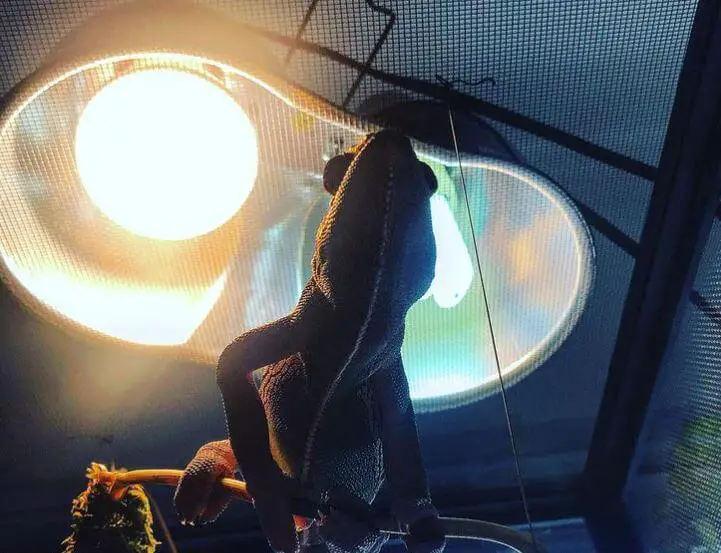What is the best lighting for chameleons?
We are chameleon owners, too, so we know how hard it is to pick the best lighting for chameleons.
They are reptiles that can not live without light.
They may not have the UVB radiation required to preserve optimum health without sunlight, but the proper lighting for chameleons is highly significant.
Your pet needs UVB and light every day to prevent metabolic bone disease and other developmental disabilities.
Thus, before making any purchase, it is highly important for you to take all the different lighting and heating products into consideration.
In case you are still confused, we hope our article will assist you to have a clearer understanding.
We also listed some good products we have tried and their reviews, so that you can choose your best suitable one.
Here are the top-rated lighting for chameleons we recommend:
- Zoo Med ReptiSun 5.0 HO T5 UVB Lamp – Top UVB Pick
- Fluker’s Basking Spotlight Bulbs – Best for Basking Spot
- Zoo Med Repti Basking Lamps 75 Watts – Best Budget
- Mega-Ray Mercury Vapor Bulb – Best Heat Lamp for Chameleons
- LUCKY HERP UVA UVB Reptile Light 5.0 – Best Compact Fluorescent Lamp
- LUCKY HERP 100-Watt UVA + UVB Full Spectrum Vapor Heat Lamp Bulb
- Zilla T8 Fluorescent Bulbs Tropical Series 25
Read on to learn more about chameleon lighting!
Related Posts:
- Best Bearded Dragon Lighting Setups for Beardie Lovers
- Best Heat Lamps for Tortoise: Reviews and Guidelines
- 20+ Tips to Setup Beardie Tank
- Best UVB Bulbs for Sulcata Tortoise
How Important Is Lighting for Chameleons?
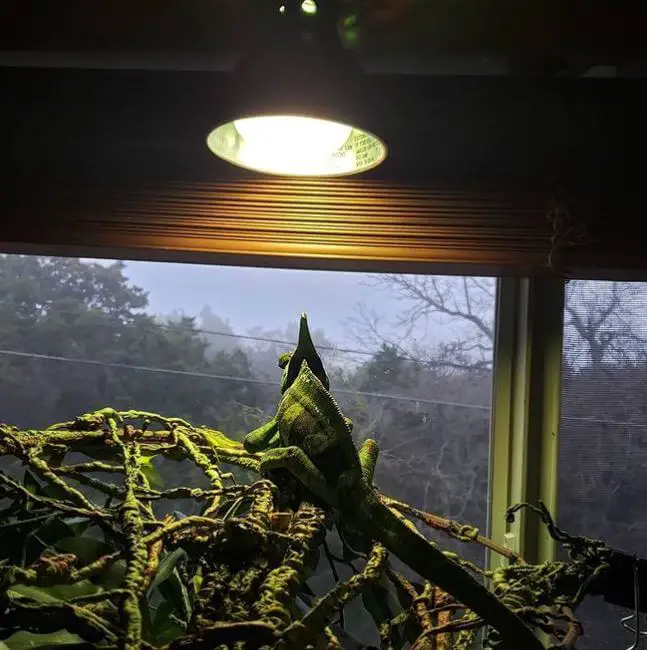
Chameleons are visual animals, which means their vision is strongly established, and light fuels it.
There is proof that they see through our human spectrum.
Photos taken with UV spectrum cameras display a dazzling variety of chameleon shapes.
Thus, this is why light is necessary for this species. For your pet to have healthy growth, the chameleon cage must be bright and fully lighted.
Sunlight has numerous effects, including a view for navigation, UVB for vitamin D3 development, and warmth for controlling body temperature.
Nowadays, we have a lot of products that have evolved to reproduce the sunshine components: vision, heat, and UV radiation.
For each of these elements, the most common and powerful technologies need different bulbs. In fact, Mercury Vapor bulbs can provide all three factors.
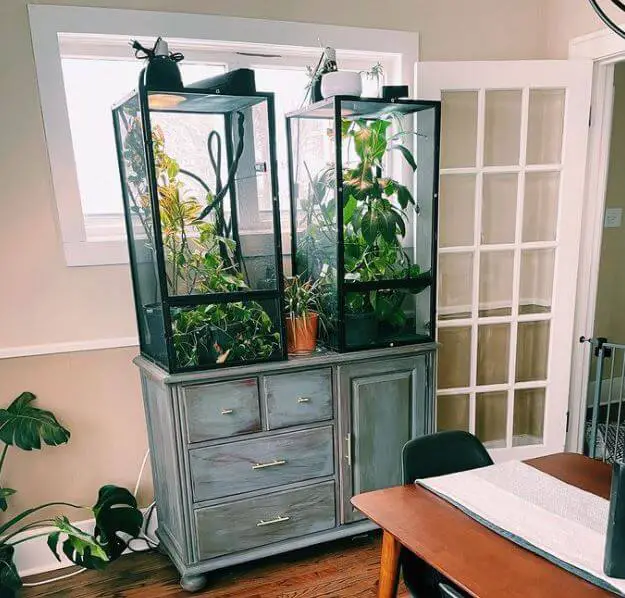
Today, as we experienced, the best light source so far is the high-output T5 fluorescent bulbs.
These are the most powerful bulbs to provide vision illumination.
A linear fluorescent bulb of 6500K T5 is the safest option for keepers who prefer bright daylight.
We suggest you use one 6500K T5 and one UVB bulb for a chameleon.
Separating fittings for daylight and UVB bulbs will be the optimal case.
What Is the Best Lighting Schedule for Chameleons?

Many of them perform better with a 12-12 hours light cycle, which means that you turn on the light for 12 hours and keep it off for the next 12 hours.
However, some certain species that live far from the equator can demand daylight varying from 9 to 15 hours per day all year round.
The difference in light will play a role in signaling the mating times, so an optimal initial setup at this time is 12 hours daytime and 12 hours nighttime.
You have to check carefully and reproduce the daylight differences due to the country of origin of the chameleon.
What Lights to Use for Chameleons?
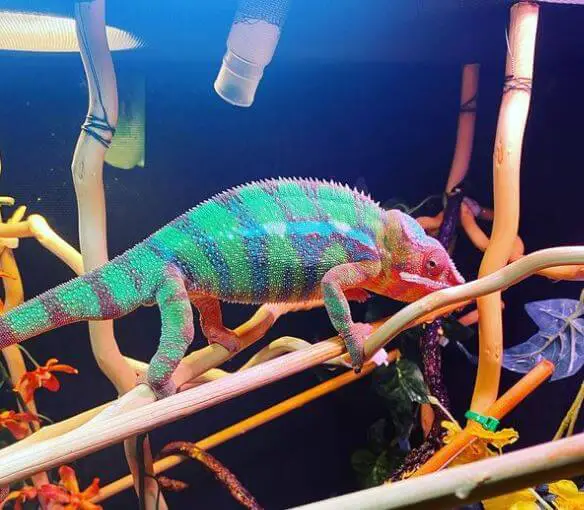
1. Heat Light
This is vital because chameleons can not control the temperature of their body, so they need the natural sun or artificial light to regulate it.
A heat lamp gives your pet a spot to bask and also helps to regulate the cage’s environmental temperature.
2. UV Light
This is also important as UVB rays are required for chameleons to develop vitamin D3 to absorb calcium from their diet.
Without it, several health problems may occur, particularly MBD (metabolic bone disease), which is extremely painful for them.
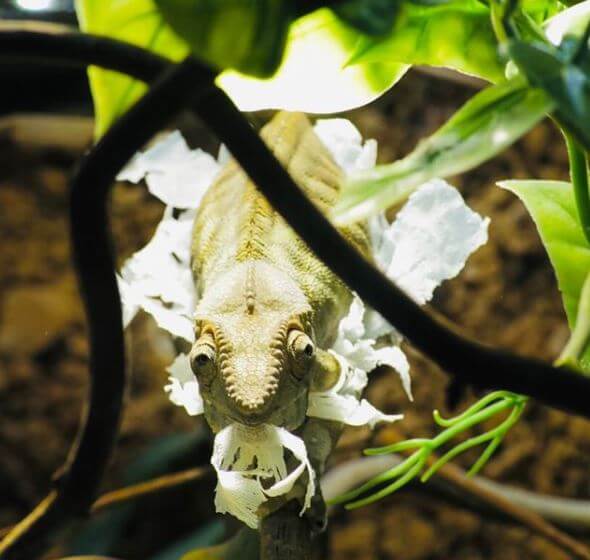
When you keep any species of reptile, make sure that you provide enough lighting and heating tools.
The illumination inside the enclosure can imitate the full benefit of natural sunlight to help your animal grow effectively.
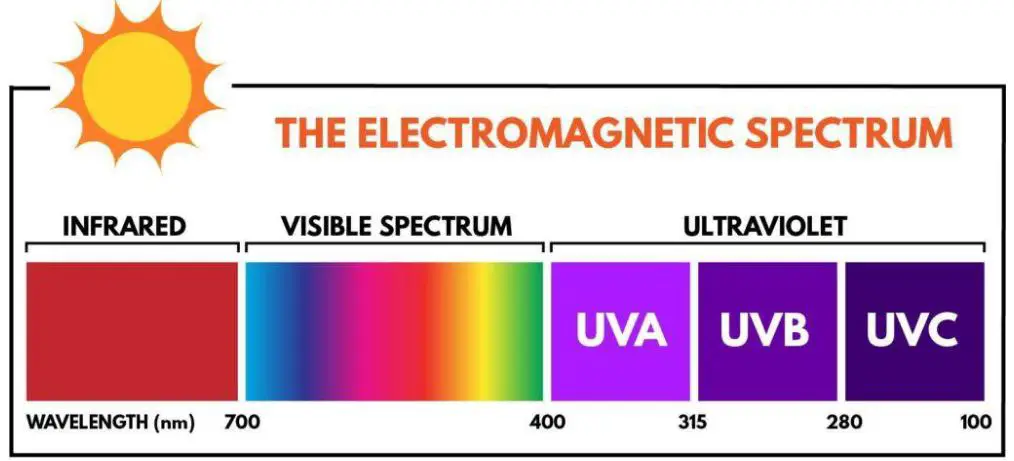
The required lighting must consist of three elements: white light and red light (the luminosity and color of the natural sun shine), and blue light (the soft glow of moonlight).
By replicating the illumination of day and night, your pet will thrive in his enclosure and so does the survival of the plant in your terrarium.
UVB rays are vital to the development of vitamin D3 by sun-basking reptiles.
Whereas a small quantity of vitamin D3 in the food they eat can be used, nearly all are unable to keep the vitamins adequate without the sunshine.
Vitamin D3 helps these reptiles to digest calcium and without it, metabolic bone disease can rapidly be developed.
It is essentially calcium leaching from the bones, which results in a number of deteriorating health problems. Therefore, lighting and UVB are a must.
3. Grow Light
In fact, this is a nonessential light to the well-being of your animal, but a strong light to illuminate the enclosure will best reveal the color of the animal.
It makes them more comfortable and involved.
A grow light is also very useful for the plants in the enclosure because it allows them to thrive even in poor conditions.
However, remember that grow light can not replace heat lamps or UVB bulbs since it gives off no rays or heat.
It is just an optional addition to the chameleon cage.
Where to Place Lights for Chameleons?
Below is an example of a temperature gradient:
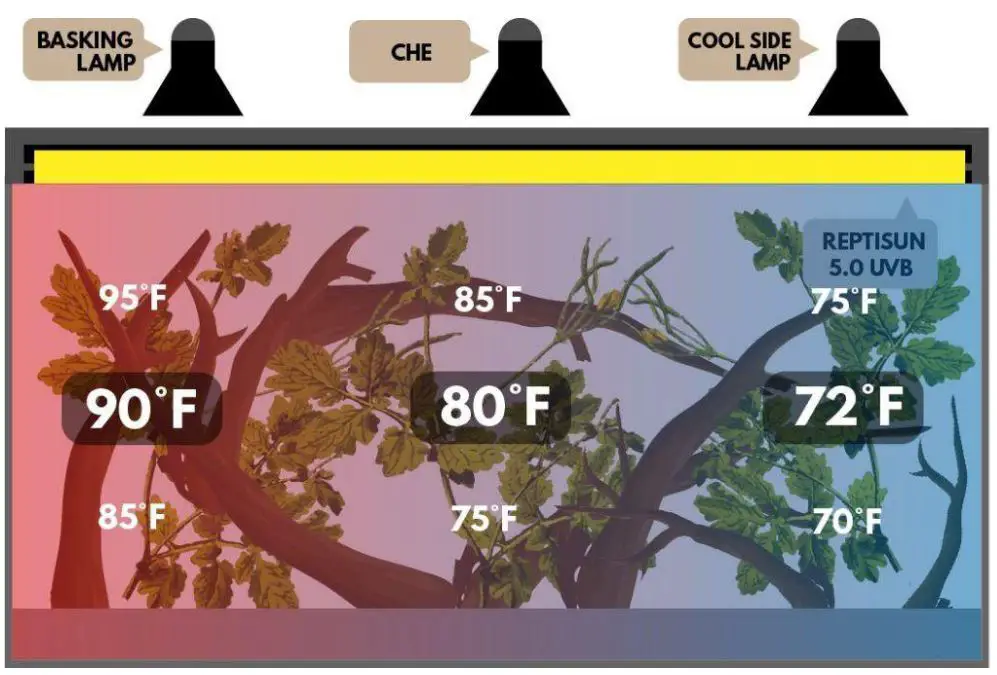
The whole terrarium should not be saturated to an evenly disbursed heat by your chameleon lighting.
The key thermal source can be easily accessed by putting the hood on one side of the inserted ceiling, with the perimeter flush, that is, on the other hand, with a dimmer lamp on the other.
Only one heat source can be installed.
Pick both sides and work across for full coverage hoods.
You can also change the height to light to achieve the same result if you do not have a dimmer on your light.
The higher the light you put, the cooler the enclosure.
7 Best Lighting for Chameleons Shortlist (Updated List)
Ratings are from Amazon at the time of publication and can change.
7 Best Lighting for Chameleons
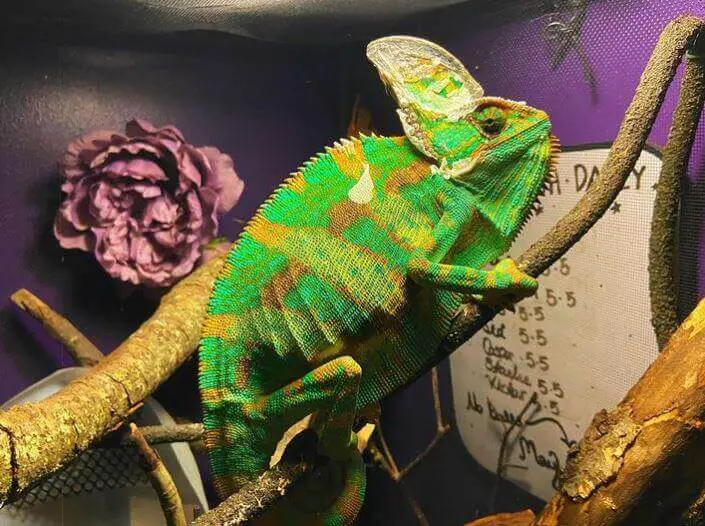
1. Zoo Med ReptiSun 5.0 HO T5 UVB Lamp – TOP UVB PICK
See Latest Price
Our top pick in the UVB bulb category for reptiles always goes to the Zoo Med Reptisun T5 UVB Fluorescent Lamp.
It gives a better output for both UVA and UVB than the other products.
The high-performance T5 lights are excellent for big and large enclosures, ensuring that your reptiles are safe and comfortable with effective UVB penetration.
The bulb can be used properly on different terrariums with different hoods and lengths.
Therefore, it is a good product for panther chameleons since they require a semi-intense UVB light source.
The Zoo Med bulb is used in accordance with the protection and reliability of UVB provision.
To ensure optimum quality, the highly polished reflector is curved.
Key Features:
- Item dimension is 23.82 x 2.17 x 0.98 inches
- Wattage is 24 watts
Pros:
- Eliminate the risk of vitamin D3 overdose from synthetic sources
- Help to induce the reproductive behaviors
- Safe and beneficial for use with all types of reptiles
Cons:
- Risk of smoking
- The price is a bit high
2. Fluker’s Basking Spotlight Bulbs – BEST FOR BASKING SPOT
Fluke’s is a popular brand for reptile owners.
Fluker’s Basking Spotlight Bulb is cheap and available in different sizes to suit the needs of various reptile cages.
However, for the chameleons, we suggest you use the 75W and 100W ones.
The basking place and several other areas in the cage will also be heated up.
A higher wattage will heat up the entire cage and save you time, but the chance of burning or overheating also increases.
Moreover, the light color is bright, but its hue is warm enough. Your pet will not be blind when looking at it.
Depending on the chosen wattage, you can use a suitable ceramic socket to ensure that the light is not burnt out.
Key Features:
- Item dimension is 2.5 x 2.5 x 5.5 inches
- The mirror lighting type is incandescent
- Wattage is 100 watts
Pros:
- Direct heat and light toward a specific area for basking reptiles
- Great value
- Different wattage options for different needs
Cons:
- Some buyers receive broken bulbs (but can be replaced or refunded)
- Gets quite hot on the surface of the bulb
3. Zoo Med Repti Basking Lamps 75 Watts – BEST BUDGET
Zoo Med Repti Basking Lamp is an alternative for chameleons that is more moderate and affordable.
Zoo Med basically took from above the same concept for the double reflector and decreased the wattage.
You will get 4 bulbs per purchase, which means that it is far cheaper than any of the items on our list.
Furthermore, 75 wattage is a recommended one for a standard-size tank.
You should place it from 6 to 7 inches above the basking spot for the best heating.
Key Features:
- Item dimension is 4 x 2.5 x 2.5 inches
- Wattage is 75 watts
Pros:
- Spotlight bulb for focus on defined areas
- Unique patented double reflector
- Strong UVB output
- Long-lasting (for 2+ months)
Cons:
- Claimed to burn quickly
- Poor shipping packages may lead to broken bulbs when received
- Will not heat the cage entirely
4. Mega-Ray Mercury Vapor Bulb – BEST HEAT LAMP FOR CHAMELEONS
Mega-Ray Mercury Vapor is one of the best lighting for chameleons that supply both UV rays and heat available on the market today.
It produces more UVB than the other ones with the new design. It is also safer for the keepers.
This self-ballasted bulb supplies the chameleons with UVB, UVA, and heat.
The decay rates of this bulb are one of the best pros so far.
While the other mercury vapor bulbs’ decay rates over time by as much as 80%, Mega-Ray bulb decays by less than 30%.
This light scatters available UVB at a maximum of 20 inches on a 30-inch circumference. Thus, it is ideal for all chameleon cage styles.
Key Features:
- Item dimension is 7.5 x 5.5 x 5.5 inches
- Wattage is 160 watts
Pros:
- UVA UVB output
- Perfect for amphibians and reptiles
- High wattage for lighting and heating
- Long lifespan (+18 months)
Cons:
- Expensive
- Could break easily when shipping
5. LUCKY HERP UVA UVB Reptile Light 5.0 – BEST COMPACT FLUORESCENT LAMP
Lucky Herb Reptile UVB is suitable for all desert reptiles but is also useful for chameleons.
It has a stable UVB output and a low fade rate. Furthermore, no dangerous UVC rays emitting, so you do not have to worry about that.
This UVB reptile light has 4 options: UVB5 15W, UVB5 23W, UVB10 15W, UVB10 23W. We suggest using the UVB10 ones for chameleons, which they need to produce calcium and vitamin D3.
Use as instructed every day to avoid the metabolic bone disorder.
The special glass tube is made with reliable and high-quality machines.
This bulb can also be presumed to be of the best quality for a long time.
Key Features:
- Item dimension is 6.7 x 3 x 3 inches
- Wattage is 15 to 23 inches
Pros:
- Affordable price for a high-quality product
- A good and stable UVB source
- The manufacturer provides a 1-month assurance service
Cons:
- Low wattage
- Only for lighting and producing UVB, not for heating and UVA
6. LUCKY HERP 100-Watt UVA + UVB Full Spectrum Vapor Heat Lamp Bulb
See Latest Price
Evergreen UVB Mercury Vapor Bulb is one of the best well-known UVB bulbs.
This is because of the price combined with the high efficiency of the product.
This 100-watt bulb gives the UVB and UVA rays required by the chameleons.
Moreover, the bulb provides the ideal heat to bask in during the day.
The Evergreen UVB Mercury Vapor is self-ballasted for protection and does not contain UVC that can damage your pet.
Key Features:
- Item dimension is 6 x 8 x 6 inches
- Wattage is 100 watts
Pros:
- Compatible with virtually all enclosures
- Tested for quality and lifespan
- No harmful UVC
- Excellent source of UVB, UVA, heat
Con:
- Fragile and could break easily when shipping
7. Zilla T8 Fluorescent Bulbs Tropical Series 25
Zilla Fluorescent Tube is a suitable product for medium to big cages.
It provides a complete lighting range that enhances the natural colors of the animals themselves and their living environment.
The best thing is their ability to cover a vast field regarding fluorescent tubes.
Contrary to the compact bulbs, T8 bulbs provide the whole cage with an eve supply of UV illumination.
The potential to be mounted anywhere in the enclosure is another benefit of this product.
It can be placed vertically on top of the enclosure.
Being mounted vertically, the bulb can penetrate the parts of the cage that are difficult to reach.
Key Features:
- Item dimension is 2.1 x 19.8 x 1.3 inches
- Wattage is 15 watts
Pros:
- Provides both UVB and UVA
- Up to 3500+ hours lifespan
- Full-spectrum lighting
- Perfect for medium and large cages
Cons:
- Fragile and could break easily when shipping
- Must be used with a T8 strip light fixture
What Makes Good Lighting for Chameleons?
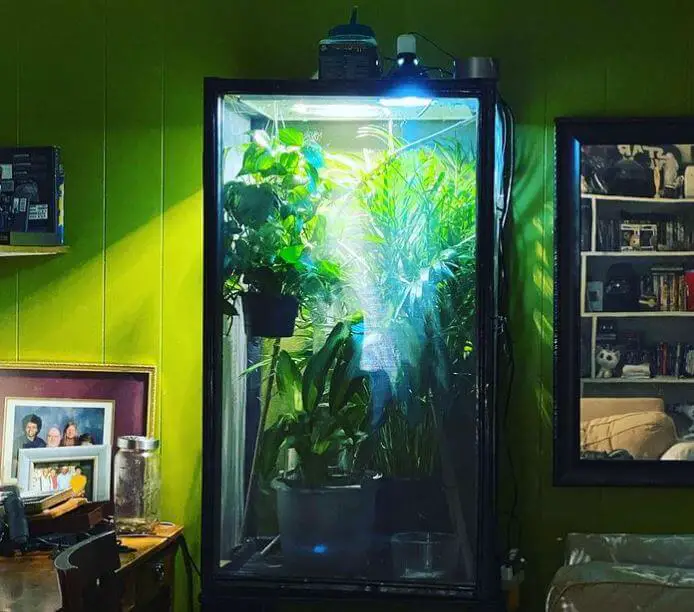
We will address some features that we think you should take a look at before making a purchase for your best lighting for chameleons.
1. Bulb Type
Many different lighting bulbs are available on the market today, but only 34 of them are ideally suited for chameleons.
They are compact fluorescent, linear fluorescent, metal halide, and mercury vapor.
The advantages and price differences of each light vary due to each type and manufacturer.
2. Wattage Output
The most important thing is the output heat of the bulb.
Knowing the appropriate wattage depends on the type of bulb used, but at least at 75W.
Having a 75W bulb would provide the basking spot and the entire enclosure with enough heat.
More than 175W can burn your pet. However, to provide both UVB rays and heat, you will need a higher wattage.
The exception is the mercury vapor with double duty.
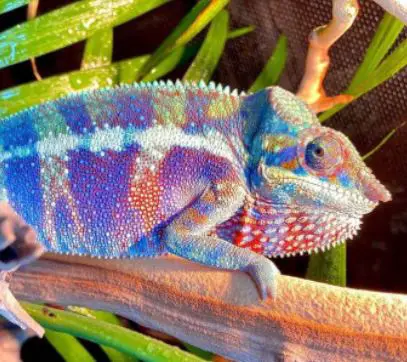
3. Heat Range
The basking bulbs have either thermal or general heat in most situations.
Even though just one bulb can work very well for a basking area, heating a chameleon cage requires a larger spectrum of heat.
Always make sure that you test the temperature and spectrum range of every bulb you buy.
Besides, remember to place the bulb high above the tank.
The chameleons may eventually hit it and be burned.
4. Longevity
Heating lamps, like those used for the basking areas, appear to have poor durability.
They only last two weeks, in the worst situation.
The best lighting for chameleons will usually lasts up to 2 months.
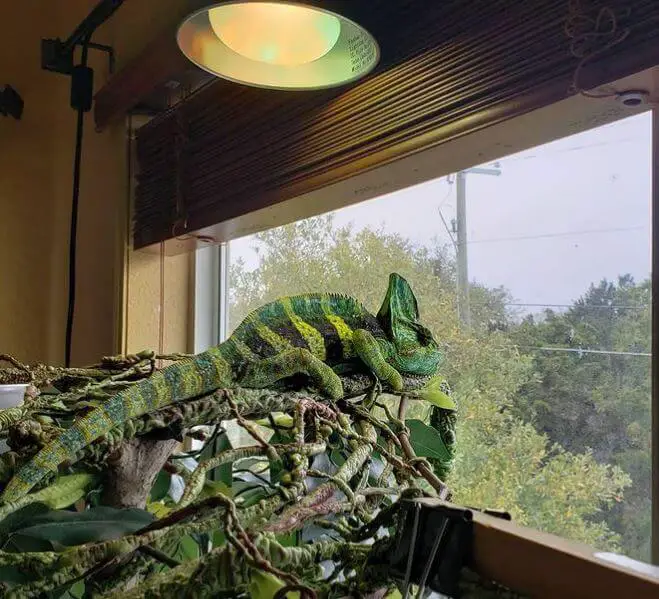
5. Socket
As heating produces a lot of heat, they store a lot of heat in the bulbs as well.
Depending on the brand and configuration of the lamp, where it connects to a socket may get very hot.
Make sure that your lamp needs a plug or not.
In certain cases, a ceramic socket is required for a heating bulb.
Without breaking or melting, the ceramic manages higher heat easier.
Watch this video for further details about choosing a good UVB lighting for your pet:
Frequently Asked Questions About Lighting for Chameleons
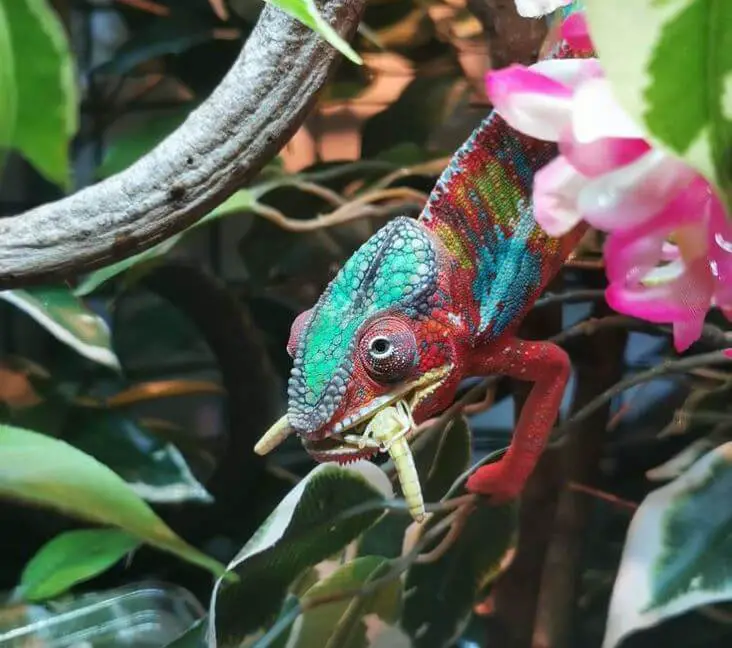
1. Can I Keep the Light On During the Night?
Some new keepers are suggested to use a red heat bulb for heating all night.
However, this is needless and dangerous.
Chameleons can see the red light and it disturbs their sleep habits.
They like to sleep in an area that is as dark as possible.
Moreover, additional heating at night is not really required, it is even unhealthy most of the time.
A decrease in the temperature at night is significant, especially for Jackson’s chameleons.
If nighttime heating is needed in certain situations, do it without light.
2. Do Chameleons Need Blue Light?
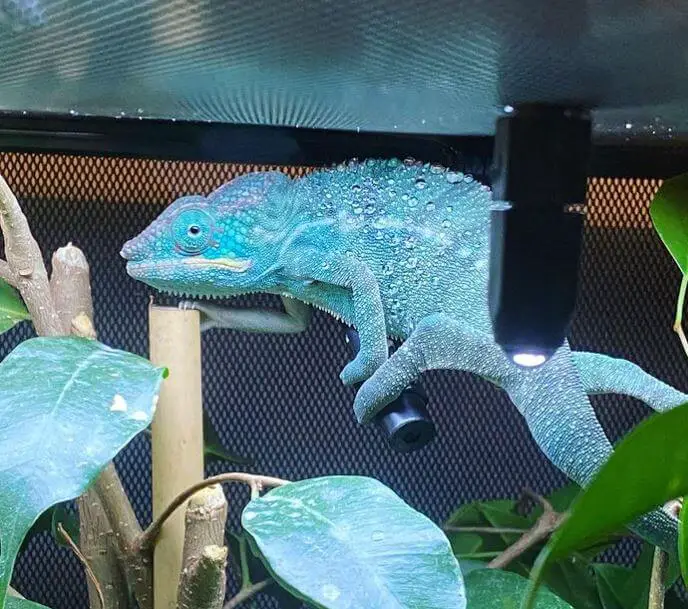
Yes. The blue light makes sure that your pet is sufficiently asleep and retains its day-night cycle.
There are those who say you even need to provide more things to mimic this cycle, such as reducing the time using lights in winter months or supplying blue and red light to imitate the moon.
3. What Are the Signs My Chameleon Gets Cold?
We can say if they are getting cold by the sign that they wear their residual colors all day long or whether they are already dark, struggling to get as much light as they can.
The dark colors mean that more heating sessions are needed.
There are other factors in the wild that could cause the chameleons to die, but their life can be lengthened by captivity where everything is controlled by their keeper.
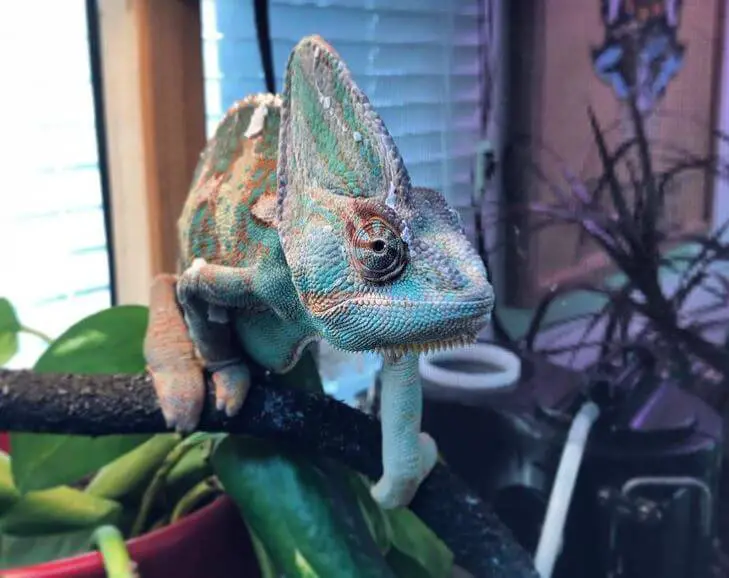
4. Why Does My Chameleon Curl His Tail?
When they get nervous, they will even curl their tails.
Much as their color varies, a curled or uncurled tail is a means for the owner to know their mood.
It may be nervous or concerned whether a chameleon is sitting with a curled tail.
Usually, they have a straight tail while they are happy.

5. What Is the Suitable Temperature Range for a Chameleon?
During the day, the cool zone should range from 70 to 80 degrees Fahrenheit (21 to 27 degrees Celsius).
For Jackson’s chameleons, the warm region should be 80 to 90 degrees F (27 to 29 degrees C), and for veiled chameleons, from 90 to 100 degrees F (32 to 38 degrees C).
Until your home sinks below 65 to 70 degrees F at night, night heating is not required.
Conclusion
What is the best lighting for chameleons? Lighting and heating are important for the strong bones of chameleons.
Just supplying calcium and vitamin D3 from a regular diet is never enough.
With the right UVB bulb, it is solved easily. You, as the keeper, must take a moment to check and pick the right one before purchasing.
There are a variety of different products to decide on and you have to keep eye care.
From our previous experiences, Zoo Med ReptiSun 5.0 HO T5 UVB Lamp is our top pick for a UVB bulb.
Of course, you will need other lighting and heating supplies, but nothing can beat the Zoo Med lamps for supplying the required UVB rays.
Mega-Ray Mercury Vapor Bulb is an ideal all-in-one choice if you do not have time or experience in setting up a pet cage.
Hopefully, after reading our article, you have known more about how to choose the best lighting for chameleons.
All the options are good, so all you have to do is consider the current situation and what you need to pick the right one.
Key points to take away for the best lighting for chameleons:
1. UVB Lighting:
- Essential Requirement: Chameleons need UVB lighting to synthesize Vitamin D3, crucial for calcium metabolism and preventing metabolic bone disease (MBD).
- Recommended UVB Bulbs: T5 High Output (HO) or T8 fluorescent UVB bulbs are suitable. Brands like Zoo Med Reptisun 5.0 or Arcadia are popular choices.
2. Basking Lights:
- Purpose: Basking lights provide heat for thermoregulation and creating a temperature gradient within the enclosure.
- Recommended Bulbs: Halogen or incandescent bulbs that emit both UVA and heat. Wattage depends on the chameleon species and enclosure size.
3. Lighting Fixtures:
- Placement: Install fixtures outside the enclosure to prevent the chameleon from getting too close and getting burned.
- Adjustable Mounts: Opt for fixtures with adjustable arms or mounts for better positioning.
4. Lighting Schedule:
- Daylight Cycle: Mimic a natural day-night cycle with 12-14 hours of light and 10-12 hours of darkness.
- Timer Usage: Use timers to automate the lighting schedule for consistency.
5. Lighting Distance and Intensity:
- UVB Distance: Ensure UVB bulbs are positioned at an appropriate distance (according to manufacturer instructions) to provide adequate UVB exposure without causing harm.
- Basking Spot: Adjust basking light distance to achieve temperatures between 85-95°F (29-35°C) at the basking spot.
6. Fixture Replacement:
- Regular Maintenance: UVB bulbs degrade over time, losing their effectiveness. Replace UVB bulbs every 6-12 months, and basking bulbs every 6 months or as recommended by the manufacturer.
7. Full-Spectrum Lighting:
- Benefits: Full-spectrum lighting mimics natural sunlight, aiding in the chameleon’s overall well-being and behavior.
- LED Options: Some LED bulbs offer full-spectrum lighting but ensure they also emit UVB/UVA if used as the primary lighting source.
8. Lighting and Enclosure Design:
- UVB Penetration: Ensure adequate exposure to UVB throughout the enclosure by positioning the fixtures to cover the entire basking and climbing areas.
- Observe Behavior: Monitor your chameleon’s behavior and health; signs of lethargy or color changes might indicate inadequate lighting.
9. Consultation and Research:
- Expert Advice: Seek guidance from experienced reptile keepers or veterinarians specializing in reptiles for specific recommendations tailored to your chameleon’s needs.
Providing proper lighting is crucial for a chameleon’s health and well-being, supporting their physical and behavioral requirements. Maintaining a balanced light setup with UVB, heat, and appropriate fixtures helps simulate their natural habitat, aiding in their overall health and vitality.
Further Reading:
- Best Bearded Dragon Starter Kits for Easy Setting Up
- Best Calcium Powders for Bearded Dragons
- Top 11 Best Substrate for Bearded Dragons
- Best Bioactive Substrate for Leopard Gecko

